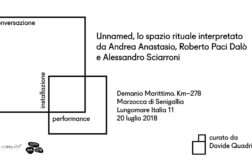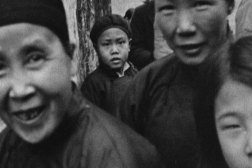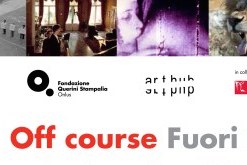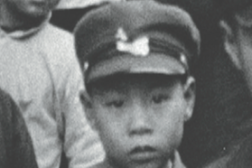


3rd Edition of DEMANIO MARITTIMO KM 278 to include Ye Shanghai
Art, Architecture, Design, Culture
Time: Friday, July 19th from 6 pm to 6 am
Location: Lungomare Italia 11
DEMANIO MARITTIMO KM 278 is a 12 hour event that features an uninterrupted flux of projects, installations, performances, lectures, readings, street food, tastings and workshops. The event is attended by Italian and international design, architecture, art and cultural production professionals.
For the full program please check here.
Project curated by Cristiana Colli and Pippo Ciorra
Marzocca di Senigallia (An), Italy
Included in the 2013 DEMANIO MARITTIMO will be Arthub produced Ye Shanghai, by artist Roberto Paci Dalo.
Ye Shanghai 夜上海 is a musical and visual performance by Roberto Paci Dalò created for SH Contemporary 2012 and produced by Davide Quadrio in collaboration with Francesca Girelli of Arthub Asia.
The project deals with several aspects of the Shanghainese life before 1949. At the core of this work is the incredible story of the Shanghai Ghetto, formally known as the Restricted Sector for Stateless Refugees (無国籍難民限定地区, mukokuseki nanmin gentei chiku).
The Ghetto was an area of approximately one square mile located in the Hongkou District of Japanese-occupied Shanghai. It housed about 20,000 Jewish refugees relocated by the Japanese-issued Proclamation Concerning Restriction of Residence and Business of Stateless Refugees, after they fled Europe before and during World War II.
The work is also related to the Japanese occupation of the city. Although Japan and China had fought intermittently since 1931, the occupation of Shanghai started in 1937 when the city fell during the Battle of Songhu. The Japanese forces occupied the Chinese administered parts of Shanghai outside of the International Settlement and the French Concession. The International Settlement was occupied by the Japanese on the 8th of December 1941 and remained occupied until Japan’s surrender in 1945.
Historical Background
“From the middle of the 19th Century, Shanghai served as a focus of Jewish immigration to China. By the end of the 1930’s, Sephardic Jews, Russian Jews and Jewish refugees from Nazi Europe in Shanghai amounted to over thirty thousand, forming the largest community in the Far East.
From 1903 to 1949, more then fifty Jewish newspapers and magazines came out in Shanghai in English, Russian, German, French, Chinese, Japanese, Polish, Hebrew and Yiddish. From 1939 to 1946 more than thirty German, Yiddish and Polish newspapers and magazines were published by Jewish refugees in Shanghai.” (Pan Guang)
The International Settlement of Shanghai was established by the Treaty of Nanking. Police, jurisdiction and passport control were implemented by the foreign autonomous board. Under the Unequal Treaties between China and European countries, visas were only required to book tickets departing from Europe. During the Japanese occupation started in 1937, the Shanghai harbor began to allow refugees to enter without any visa or passport. By the time most German Jews arrived, two other Jewish communities had already settled in the city: the wealthy Baghdadi Jews, including the Kadoorie and Sassoon families, and the Russian Jews. The last ones, forced to flee the Russian Empire because of the anti-Semitic pogroms fostered by the tsarist regime and the Bolshevik class warfare, had formed a Russian community in Harbin and subsequently in Shanghai.
The Project
Roberto Paci Daló’s project will culminate with a performance based on visual and audio materials from the years between 1933 and 1949. This database, composed of historical media, will be converted into a contemporary art work based on live video projections and music.
The iconic material used as a departure for this work is Nights of Shanghai (夜上海), a song interpreted by Zhou Xuan (1918-1957). This hit from the 1940’s will represent the aural and sonic environment of the piece. Being sampled, decomposed and recomposed, it will become a texture that will embrace the entire performance. From the enlarged texture of this song, components will gradually emerge made out of live instrumental sounds (a small ensemble will play on the central staircase of the Shanghai Exhibition Center’s main hall), samples from archive materials (voices in English, Yiddish, Chinese and German), will recreate soundscapes from the past, along with electronics sounds.
The projected images will be selected from the archive materials, including films, photographs and handwritten notes. The projections will be controlled in realtime during the performance.
This project also presents a strong connection with Italy, since many refugees heading to China were leaving from the ports of Trieste and Genoa. Those who managed to purchase tickets for the Italian Lloyd Triestino steamships, later described their luxurious journey as surreal. From the persecution in Europe to a squalid ghetto in Shanghai, that three-week cruise in between, plenty of food and entertainment, represented an unreal and dreamy rite of passage.
The project is created by Roberto Paci Dalò in collaboration with Yu Xiaolu, Zhang Yinyi, Yu Xueou, Tan Mei and Sun Mengxuan. They first met during a workshop by Paci Dalò at the SIVA Shanghai Institute of Visual Art in May 2012, an event hosted by ArtHub Asia and supported by Aike Gallery.
During the preparation of the project, throughout the summer of 2012, the team will work both at ArtHub headquarters (located in the M50 art district) and at the iTOPIA Management Consulting Co. Ltd.’s space. iTOPIA’s, “Mid-lake Pavillion” is located in the heart of the Hongqiao New Town Central Park in downtown Shanghai.
Ye Shanghai premiered on September 6th at SH Contemporary Art Fair, Shanghai.




